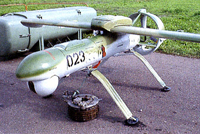Not UFO, but a Bee over Dagestan (Part I)
According to Russian journalist Vyacheslav Fyodorov, the UFO sighted over Dagestan on November 14, 2000 was actually an advanced Russian weapon, an unmanned aerial vehicle (UAV). The sighting was widely reported throughout the world after the initial story carried by Interfax Agency; Philip Mantle and my new book about Russian ufology contains a detailed account of this and other fascinating sightings and UFO reports from the Caspian Sea. Dagestan is one of the republics of the former USSR; a part of the Russian Federation, it is located between Caspian Sea on the East and Caucasus mountains on the West; it borders Chechnya.

Combining Mr. Fyodorov’s information and some thorough independent research, I have found out the following.
In March of the year 2000, the Russian Defense Ministry had approved an unmanned reconnaissance system Stroy-P (unmanned reconnaissance complex or PRC). The system was created in the Yakovlev Experimental Design Bureau, a major Russian military aircraft manufacturer, (OKB imeni Yakovleva) named for A. S. Yakovlev, a famous Soviet aircraft designer. The Yak Aircraft Corporation is now a privatized Russian aviation corporation. Pchela (a drone component of the complex) was built, as far as is known, at the Kishtim Radio Plant, with the help of the Smolensk Aviation Plant (while the Smolensk Aviation Plant joined with the Yakovlev Design Bureau in March, 1992 to form the Yak Aviation Company, the two entities seem to be operating separately); the official maker of the Pchela is Kulon Scientific Research Institute (R&D Institute of Aircraft Technology). This system, or complex, includes a launcher on caterpillar-fitted platform, two vehicles and ten (initially, five) Pchela-1T 061 aircraft. The Stroy-P complex was accepted for service with the Russian Army in 1997.
A Pchela (remotely piloted reconnaissance drone that provides television surveillance of ground targets) weighs 130 kilograms (loaded), has an operational range of 110 to 150 kilometers, can fly at altitudes ranging from 100 meters to 3 kilometers, and cruises at speeds from 11- to 150 kilometers an hour. Combat-recorded range: 55 kilometers. Its flight endurance is 2 hours (it needs 20 liters of gasoline for this). Its power plant is piston plus two solid rockets takeoff boosters (power at 32hp). Onboard of the Russian drone are a video camera, a still camera, a mapping camera, and a secure radio. It uses a parachute for landing. Pchela is probably equal in capability to many Western UAV in the same class. However, it is a slower, tactical unmanned aerial vehicle than, for example, the Russian the 800-kilometer-per-hour Reis UAV.
The chronology is as follows: in 1982, the Soviet military gave instructions to the A.S. Yakovlev Design Bureau to develop a small, remotely piloted aerial vehicle (distantsionno-pilotiruemiy letatel'niy apparat, or DPLA). The person in charge of the project was a talented designer, Yuri Yankevich . Years later, a DPLA-605 Pchela was developed. This was first Soviet UAV capable of monitoring ground targets with an on-board television camera that had a real-time downlink. Later, Pchela (Russian word for a honey bee), the unmanned tactical reconnaissance drone (bespilotnyi samolet, in Russian), was modified to Pchela-1T (TV observer), Pchela-1IK (new version ), and according to www.aviation.ru/Yak/ , to Expert , a 5-th generation unmanned tactical reconnaissance drone to replace Pchela from the Stroy-P system.
Back in the summer of 2000 the Russians were conducting test flights of their Pchela-1T light unmanned reconnaissance aircraft, according to Mr. Fyodorov . Apparently, Russian media carried stories about the “airplane-robot” and its onboard TV camera. The Pchela drones tested in November of 2000 are also equipped to fly in the nighttime and have infrared vision capability. The timing of the UFO sighting over Dagestan and the tests of the Pchela drones coincide.
To be continued…
Paul Stonehill
Russian Ufology Research Center
Subscribe to Pravda.Ru Telegram channel, Facebook, RSS!





